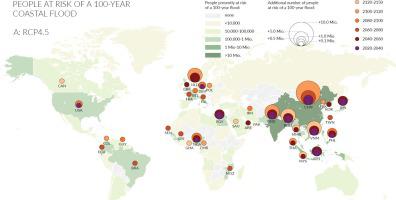Climate Risk Management ( IF 4.4 ) Pub Date : 2021-09-04 , DOI: 10.1016/j.crm.2021.100355 Marjolijn Haasnoot 1, 2 , Gundula Winter 1 , Sally Brown 3, 4 , Richard J. Dawson 4, 5 , Philip J. Ward 6 , Dirk Eilander 1, 6

|
Without adaptation, sea-level rise (SLR) will put more people at risk of flooding. This requires a timely and adequate commitment to adaptation. In this paper, we show how adaptation needs to unfold over time to manage climate-induced SLR. We use a novel scenario-neutral approach, applied globally and subsequently combined with SLR and population scenarios, to assess when, where, and how fast to adapt up to 2150. As rates of SLR accelerate, adaptation needs to occur at an increasing pace or at a larger scale. While it is certain that adaptation will be necessary, it is uncertain when and how fast. After only ∼ 0.15 m SLR relative to 2020, 1 million people need to adapt to permanent submergence and the amount of people at risk of a 100-year flood increases with 21% to 83 million people. This would occur in the next 30 (20–45) years for RCP4.5 and within 25 (18–36) years under RCP8.5, assuming no change in protection or population. The uncertainty in timing increases with higher SLR, albeit for some impacts it can still a matter of time. Population at risk of a 100-year flood doubles after 0.75 m SLR which could occur by ∼ 2080 (2068–2088), 2100 (2085–2130), or 2150 (2115-beyond 2150) under a high-end, RCP8.5, or RCP4.5 scenario respectively. The rate, at which the risk increases, differs strongly per country. In some countries an additional 1–5 million people of the present population will be at risk of a 100-year flood within the next two decades, while others have more time to adapt but will see rapid growth of risk past 2100. Combining SLR impacts with projected population change further increases the number of people at risk of a 100-year flood by ∼13% between 2040–2060 (under both RCP8.5-SSP5 and RCP4.5-SSP2). This can be managed through protecting, floodproofing or limiting developments in high-risk areas. A commitment to adaptation is inevitable to maintain risk at present levels. With increasing warnings of the potential for accelerated SLR due to rapid ice sheet melt, adaptation may need to happen faster and sooner than previously anticipated which can have consequences for how to adapt. Failure to acknowledge the potential and long-term (including beyond 2100) adaptation commitment in development and adaptation planning may lead to a commitment gap and subsequently expensive retrofitting of infrastructure, creation of stranded assets, and less time to adapt at greater cost. In contrast, considering the long-term adaptation commitment can support timely adaptation and alignment with other societal goals.
中文翻译:

长期海平面上升需要对适应做出承诺:一级评估
如果不适应,海平面上升 (SLR) 将使更多人面临洪水风险。这需要对适应作出及时和充分的承诺。在本文中,我们展示了适应需要如何随着时间的推移展开以管理气候引起的 SLR。我们使用一种新颖的情景中立方法,在全球范围内应用并随后与 SLR 和人口情景相结合,以评估适应到 2150 年的时间、地点和速度。随着 SLR 的速度加快,适应需要以越来越快的速度发生或在更大的范围内。虽然肯定需要适应,但不确定何时以及多快。在相对于 2020 年仅 0.15 m SLR 之后,100 万人需要适应永久淹没,面临 100 年一遇洪水风险的人数增加了 21%,达到 8300 万人。对于 RCP4,这将在未来 30(20-45)年发生。5 并且在 RCP8.5 下的 25 (18-36) 年内,假设保护或人口没有变化。时间的不确定性随着 SLR 的升高而增加,尽管对于某些影响,它仍然是时间问题。在 0.75 m SLR 之后,面临 100 年一遇洪水风险的人口会翻倍,这可能在 2080 年(2068-2088 年)、2100 年(2085-2130 年)或 2150 年(2115-2150 年之后)在高端 RCP8.5 下发生,或分别为 RCP4.5 方案。风险增加的速度因国家/地区而异。在一些国家,现有人口中将有 1-500 万人在未来 20 年内面临 100 年一遇的洪水风险,而另一些国家则有更多的时间来适应,但在 2100 年之后风险将迅速增加。将 SLR 影响与预计的人口变化相结合,在 2040 年至 2060 年之间(在 RCP8.5-SSP5 和 RCP4.5-SSP2 下),面临 100 年一遇洪水风险的人数进一步增加了约 13%。这可以通过保护、防洪或限制高风险地区的开发来管理。为了将风险维持在目前的水平,对适应的承诺是不可避免的。随着冰盖快速融化可能导致 SLR 加速的警告越来越多,适应可能需要比以前预期的更快、更快地发生,这可能会对如何适应产生影响。未能承认发展和适应规划中的潜在和长期(包括 2100 年以后)适应承诺可能会导致承诺缺口和随后昂贵的基础设施改造、搁浅资产的产生、更少的时间以更高的成本适应。相比之下,考虑长期适应承诺可以支持及时适应并与其他社会目标保持一致。



























 京公网安备 11010802027423号
京公网安备 11010802027423号